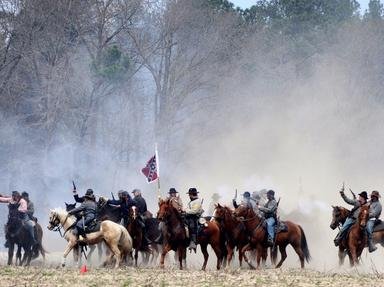Quiz Answer Key and Fun Facts
1. Following the surrender signing at Appomattox, Lee and Grant each picked three commissioners to arrange the details of the actual troop surrender. For the South were Lieut. General James Longstreet, Major General John Brown Gordon, and Brigadier William Pendleton. Who were the three commissioners that Grant appointed for the north?
2. The last Confederate offensive attack of any size in the war took place near what city on what date in 1865?
3. Wilmer McLean, in whose home Lee surrendered to Grant on April 9, 1865 in Appomattox Court House, VA, famously said what?
4. Union MG Godfrey Weitzel commanded the Union troops that were immediately outside Richmond as Lee's troops evacuated Petersburg. Weitzel knew just about everything going on within the city of Richmond. How?
5. Immediately prior to calling for a cessation of hostilities on April 9, 1865 at Appomattox, who made the first demand for a surrender, and to whom?
6. During his meetings on the steamer River Queen, Lincoln decided to take Mrs. Lincoln, Mrs. Grant, and some other high ranking general officer's wives to a review of MG Ord's troops near Peterburg at the end of March, 1865. What unpleasantness occured?
7. The last reported hostilities during the era of the Civil War as reported by the Official Records of the War of the Rebellion took place where?
8. A study of the events surrounding the selection of Joshua Lawrence Chamberlain of Maine as the Union officer to accept the surrender of southern arms and flags at Appomattox on April 12, 1865 indicate that one man had an eminent part in naming Chamberlain to the duty. Who was that?
9. Prior to the Grand Review, then Bvt. Major General Joshua L. Chamberlain sent to Tiffany's in New York to order a special pin to be given to the last Commander of the Fifth Corps, Charles Griffin. What else did he buy at Tiffany's?
10. In April of 1865, why couldn't recently killed CSA Lieutenant General Ambrose Powell Hill be buried in Hollywood Cemetery in Richmond?
11. During the Grand Review of Union troops in Washington on May 23 and 24, 1865, what event caused the gossip wags and political watchers to go into high gear?
12. At the surrender ceremony at Appomattox Courthouse on April 12, the proceedings went as well as could be expected. Generally, there were no major insults or disrepect offered other than minor quips, except one. Which former governor of Virginia said to Chamberlain "You are mistaken, sir, we won't be forgiven, we hate you, and that is the whole of it"?
13. Following the end of the Civil War, the US Congress in 1866 voted to have the War Department compile and complete a thorough compilation of all records of all kinds pertaining to all facets and operation of the Civil War, both Union and Confederate. How many years did it take before the final opus was printed and distributed, and how many total volumes did the final set contain (not including the book of maps)?
14. Who was ordered to blow up the three remaining ironclads anchored in the James River when Richmond was abandoned.
15. At the surrender signing at the Wilmer McLean home in Appomattox Courthouse, Lee sat at one table and Grant at a second. What were the last dispositions of the tables?
16. CSA Lt. Genl Richard Stoddard Ewell following Gettysburg fell into poor health and was assigned to command the defenses of Richmond. Immediately prior to the surrender of Richmond, Ewell and the few meager troops he had left to join Lee's forces at Petersburg. Ewell was not at the surrender at Appomattox. What happened to him?
17. When Ulysses S. Grant got word of Lincoln's assasination and of a possible conspiracy to murder all high-ranking Union polititians and officers, what did he do?
18. The last planned event to be handled in the evacuation of Richmond was the burning of Mayo's bridge on Monday, April 4, 1865. Who was the last CSA general officer to cross the bridge over to Manchester before the bridge was set afire?
19. What is John Wilkes Booth's connection to the widely used colloquial expression "your name is mud", meaning your chances of being looked on favorably are low, indeed?
20. Lee's surrender to Grant at Appomattox Court House, VA, on April 9, 1865, did not officially end the Civil War. How many other recognized surrenders of any size were still to come?
Source: Author
gizmo61
This quiz was reviewed by FunTrivia editor
bloomsby before going online.
Any errors found in FunTrivia content are routinely corrected through our feedback system.
